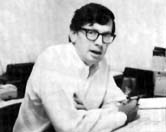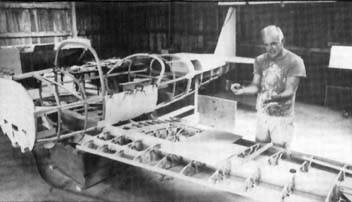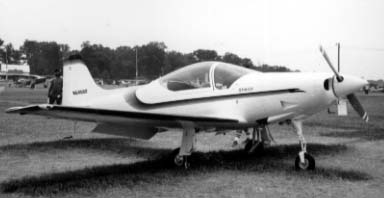Frati-ernity
![]()
Frati-ernity |
|
by Stephan Wilkinson
This article appeared in the November 1984 issue of Pilot magazine in England. |
Seven years ago, the Christen Eagle aerobatic biplane revolutionized at least one part of the homebuilding craft: it was offered as a complete kit-a life-size model airplane-many major components of which were pre-assembled, and the kit included every system, accessory, attachment and option that could be applied to the airplane. The nearly-$30,000 total price (now more like $47,000) was a revolution as well, for it was well above the cost per seat of factory-built airplanes.
Over 6oo such biplanes-in-a-box have been sold-roughly as many Eagles as there are Piper Dakotas, an airplane that went on sale at about the same time-and the allure of the expensive, all-inclusive model-airplane-kit approach to homebuilding is unquestionable. Breathes there a pilot older than styrofoam who has not lovingly X-Actoed, glued and sanded a prized balsa model, after all? And haven't we all imagined doing it full scale, making a real airplane?

Alfred P. Scott
The very same year that Frank Christensen announced the Eagle, an amiable and slightly baffled young Virginian, Alfred P. Scott, quietly began a project that bears many similarities-and one big difference-to the Christen. Alfred Scott acquired the rights to sell the plans for Stelio Frati's classic Falco F.8L and soon found himself also developing a complete-kit homebuilt airplane of the highest possible quality, at a price to match, using traditional components. Christensen's Eagle and Scott's Falco are inarguably the class acts of the homebuilt-kits stage.
The big difference, however, was that for years, while the fierce, multicoloured bird on the flanks of Christensen's biplane became an increasingly common sight at airports and air shows, Alfred Scott's Falco became a bit of a joke among homebuilders. It was the airplane that never would fly, the homebuilt too complex to build, the dream that still wanted wings. Alfred Scott? Oh, he's the wacko in Richmond who's selling blueprints for that Eytalian hot rod, right? Heads would shake knowingly. EAAers would swap stories about the thousands of hours required to build a wooden wing that tapered in every dimension, segueing from one airfoil at the root to another at the tip, and the prognosis was basements full of unfinished Falcos. (It didn't help that the EAA magazine Sport Aviation's own craftsman-columnist Tony Bingelis, who was building one and writing about it, was apparently in if not over his head at least up to his chin.
Late in the spring of 1982, the first plans-built Falco flew. This summer, the second U.S. Falco appeared at Oshkosh, but more important, it was the first to be constructed entirely from Scott's remarkable series of airframe, instrument-panel, interior and systems kits. "Frati's aircraft was a beautiful design," Scott says, "but the systems were an afterthought. Frati sat down, an idealistic 36-year-old intent on designing the perfect aircraft, but then at some point the shop took over." The result was some classically Italian jury-rigging of systems, patching of problems and development of da Vincian mechanism. Plumbing went through the firewall wherever there was room, a section of the flap-actuating system used fully fifty parts where Scott has needed three, and there were devices such as a tachometer cable passed directly through the forward fuselage tank (via a brazed-in-place little tunnel) rather than making use of a simple angle drive. Ettore Bugatti, that master of mechanical overcomplication and unmaintainability, would have loved it.
"Building a Falco from the plans and raw materials alone is the craziest thing you could do now that the kits are available," Alfred Scott admits. He guesses it would take 10,000 to 12,000 hours, which is almost six years of nine-to-five, five-day weeks. Using the kits, Scott puts the building time at 1,500 to 2,000 hours and estimates a total outlay at $45,000 to $47,000 including everything but avionics. "This isn't one of those mythical airplanes that you pour out of a bottle and two hours later you're flying," he warns. "It's not a difficult one to build, but it does take time. Still, it's getting easier all the time as the guys riding point-the earliest builders who are farthest along-constantly come back to me with shortcuts and advice.
Scott is currently working on the last major stage of the project. The final kit-an entire new cowling and redesigned engine-cooling baffles-is being put into production by one of his outside suppliers (unlike Christensen, Scott manufactures nothing himself). The clear, precise, extensive plans are complete, and now Scott is revising the contruction manual, taking into account everything he has learned from his builders. When it's done, Alfred Scott feels he'll have brought the Falco from a ridiculously labor-intensive factory design to one of the easiest-to-make homebuilt on the market, perhaps do-able in as little as 1,200 hours. To say nothing of it being arguably the most beautiful, certainly one of the most efficient and easily one of the most proven designs available. "Remember, Scott says, "this is not an amateur design. About 100 were manufactured in Italy, and the design has been flying for thirty years."

Joel Shankle and his Falco project
Scott's Falco kits are awesomely well thought-out. There are dozens of spare electrical connections already in place for future avionics and systems, all the wiring is not only color-coded but cut to length and complete with pins and receptacles, all panel placards and custom instruments use the same type face, the five-belt restraint system is rated at forty g (U.S. production provide 9 g) and three specific engine installations are allowed for-fuel-injected Lycoming 320s of 150 and 160 hp and a 180-hp IO-360 for the best possible take-off and climb performance.
Scott favors the 160, and in fact will allow no modifications beyond the three specific powerplant options and the exact materials, dimensions and procedures spelled out on the plans. Do it his way or you'll never buy another part from Scott-a point that annoys many inventive homebuilders-nor will you be allowed to call your airplane a Falco. He feels he's selling a safe, proven design that doesn't need your additional expertise or mine, and if you insist on providing it and cause a crash, he doesn't want the lawyers knocking at his door.
The renaissance of the Falco would be a remarkable accomplishment for a full-time engineer with an extensive aviation background for whom drafting was second nature. (The packet of 113 blueprints and 190 instruction sheets that Scott sells for $400-easily the best plans on the homebuilt market-are only the tip of the iceberg; in his Richmond office are the thousands of sheets that he has had to draw and redraw for suppliers producing the kit components.)
But what is even more remarkable is that Alfred P. Scott is a University of Virginia graduate with a degree in speech and drama, a pilot's licence that he really hadn't much used since he was a teenager, a reputation as a bluegrass musician and bagpiper that far exceeded his accomplishments as an aviation manufacturer and a career that had included stint as a Merrill Lynch stockbroker and then as a real-estate speculator/developer. "I had over a million dollars invested in this project before I'd ever seen a Falco, much less flown one," Scott laughs. (He has since corrected that by importing the only production Falco currently flying in the U.S.)

Dave Aronson's kit-built Falco
Such experience apparently has served Scott well, however, for he runs his company, Sequoia Aircraft, like a business, not an airplane enthusiast's hobby or an entrepreneur's get-rich-quick scheme. Scott may not be a Burt Rutan-and he'd be the first to point out that he leaves all the actual Falco redesigning to consultant David Thurston, a highly respected ex-Grumman engineer with a number of lightplane designs to his credit. But nor is he a Jim Bede, for Sequoia's Richmond warehouse is stocked with a $1,000,000 investment in Falco kit parts fully paid-for by Scott, who obviously is not a poor man. And when the Falco catches the fancy of homebuilders who suddenly discover that it is no longer an Italian nightmare but a delightful do-it-yourself kit, Alfred Scott will make a richly deserved million dollars.
If you want a complete and dangerously persuasive Falco information kit, send $12 to Scott at Sequoia Aircraft Co,. P. O. Box 6861, Richmond, Virginia 23230, U.S.A. And if it ends up costing you 4,000 times that amount, don't say I didn't warn you.
|
|